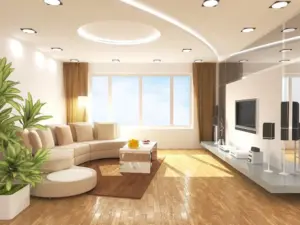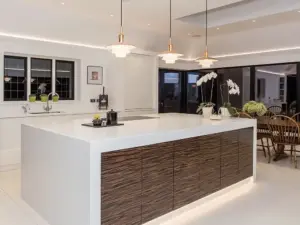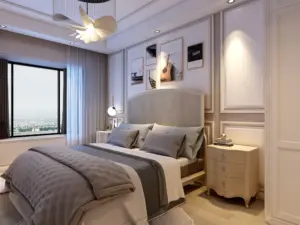Introduction:
Lighting is a crucial aspect of any living space. It illuminates the surroundings and affects a room’s mood, productivity, and overall ambiance. When choosing the proper lighting for a room, understanding lumens per square foot is essential. Lumens are a unit of measurement that quantifies the amount of visible light produced by a light source.
Determining the appropriate lumens per square foot for a room ensures that the space is adequately lit for its intended purpose. This article will discuss the recommended lumens per square foot for various rooms. It will help you make informed decisions about your lighting needs.
Understanding Lumens
First, let’s understand what lumens are and how they relate to lighting.
Lumens measure the brightness of a light source, which is the amount of visible light emitted. The higher the lumens, the brighter the light. Unlike watts, which measure energy consumption, lumens specifically quantify the light output. To choose the right lighting for a space, it’s essential to consider the lumens in relation to the room’s size and purpose.
Factors Affecting Lighting Needs
Now, you might question how many lumens I need for each room. The appropriate lumens per square foot for a room depend on several factors:
- Room Size: The size of the room directly affects how many lumens to light a room are needed. A larger room requires more lumens to ensure adequate lighting coverage.
- Room Functionality: The purpose of the room is crucial in determining the necessary lumens. For example, a kitchen or workspace may require higher lumens compared to a bedroom or living room.
- Color and Décor: The color of walls, ceiling, and furnishings can impact the way light is reflected and absorbed. It influences the overall lighting needs.
- Age and Vision: As people age, their eyes may require more light to maintain visibility. Consider the occupants’ age and visual acuity when determining lighting requirements.
Recommended Lumens per Square Foot by Room
Let’s explore the recommended lumens per square foot for various rooms in a typical household:
1. Living Room

The living room is a multifunctional space where various activities occur. They include reading, socializing, and watching television. Therefore, a balanced lighting approach is essential. So, how many lumens for living rooms are needed?
- General Lighting: Aim for around 10-20 lumens per square foot. For example, for a 200-square-foot living room, you’d need 2,000-4,000 lumens.
- Task Lighting: For specific activities like reading, consider 50-75 lumens per square foot. It is to ensure ample lighting in the designated areas.
2. Kitchen

The kitchen is a workspace that demands adequate and bright lighting to ensure safety and efficiency. It is essential, especially during food preparation.
- General Lighting: 20-30 are recommended lumens per square foot to adequately illuminate the entire kitchen area.
- Task Lighting: For task-specific areas like countertops and stovetops, aim for 70-100 lumens per sq ft.
3. Bedroom

The bedroom is a space for relaxation and comfort. It requires softer and more subdued lighting compared to functional spaces. So, how many lumens do I need for a room, and how do I determine?
- General Lighting: 10-20 lumens per square foot are usually sufficient for general bedroom lighting.
- Reading Lights: For reading areas, consider 50-75 lumens per square foot for ample lighting.
4. Bathroom
The bathroom requires a mix of lighting for various tasks, including grooming and relaxation.
- General Lighting: 20-30 lumens per square foot for overall illumination.
- Task Lighting: Aim for 75-100 lumens per square foot around the mirror and vanity area for effective grooming.
5. Home Office
In a home office, adequate lighting is crucial for productivity and reducing eye strain.
- General Lighting: Aim for 30-40 lumens per square foot.
- Task Lighting: Provide 50-75 lumens per square foot at the work desk or reading areas.
6. Dining Room
The dining room requires a balanced lighting scheme for both functional and aesthetic purposes. So, how many lumens per sq ft do I need?
- General Lighting: Aim for 20-30 lumens per square foot.
- Accent Lighting: Consider adding accent lighting, such as chandeliers or pendant lights. It will enhance the ambiance.
Smart Lighting and Automation
Advancements in lighting technology have brought smart lighting solutions and automation into homes. Smart lighting offers a higher level of control and customization over the lighting environment. It allows for the adjustment of brightness, color, and temperature. You can even operate lighting schedules through mobile apps or voice commands. Here’s how smart lighting can enhance your understanding of how many lumens do I need:
1. Smart Lighting Systems
- Adjustable Lumens: Smart lighting systems often come with adjustable brightness settings. It allows you to understand how many lumens per sq ft and easily modify the lumens emitted by each light fixture. This adaptability is especially useful for altering the lighting intensity based on the room’s needs and time of day.
- Color Temperature Control: Some smart bulbs and fixtures offer the ability to control the color temperature by only supplying the required lumens needed per square foot. This feature is valuable for creating different moods in a room. For instance, warm light in the evening for relaxation and cool, bright light during the day for productivity.
- Scheduling and Automation: Smart lighting allows you to turn lights on or off automatically. By programming your lights to adjust throughout the day, you can achieve the desired lumens per square foot.
2. Energy Efficiency and Cost Savings
- Efficient Energy Consumption: Many smart lighting solutions utilize energy-efficient LED bulbs. LED lights consume significantly less energy while providing high lumens output. It makes them an eco-friendly and cost-effective option for homeowners.
- Energy Monitoring and Insights: Some smart lighting systems provide energy usage data and insights. By monitoring your lighting’s energy consumption, you can make informed decisions.
Thus you can also optimize the lumens per room while minimizing energy waste and reducing your utility bills.
3. Adaptive Lighting for Health and Well-being
- Circadian Rhythm Lighting: Smart lighting can mimic natural lighting patterns. It can also adjust color temperatures and brightness levels throughout the day to align with the body’s circadian rhythm. This can positively impact your health and well-being. It improves sleep quality and promotes alertness during the day.
- Reducing Eye Strain: Smart lighting can help reduce eye strain and fatigue. It enhances comfort and productivity, especially in spaces like home offices.
Additional Tips for Optimal Lighting
1. Layered Lighting: Utilize a mix of ambient, task, and accent lighting to create a layered and versatile lighting scheme in each room.
2. Energy Efficiency: Consider using LED lights, which offer high lumens while being energy-efficient. It reduces energy consumption and utility costs.
3. Dimmers: Install dimmer switches to adjust the brightness of the lights based on the time of day. You can also adjust for specific activities, providing flexibility in lighting levels.
4. Natural Light: Incorporate natural light into your lighting plan wherever possible. It is not only energy-efficient but also positively impacts the overall mood and well-being.
FAQs: Lumens Per Square Foot for Your Room
Q1: What are lumens, and why are they important for lighting?
A1: Lumens are a unit of measurement that quantifies the amount of visible light emitted by a light source. In lighting, lumens are crucial as they indicate the brightness or light output of a bulb or fixture. Understanding lumens helps in choosing the right lighting for a space.
Q2: How do room size and function affect the recommended lumens per square foot?
A2: Room size directly affects the lumens needed; larger rooms require more lumens to ensure adequate lighting. The room’s function is equally important. For example, task-oriented areas like kitchens or workspaces require higher lumens per square foot. It is in comparison to relaxation spaces like bedrooms or living rooms.
Q3: How can I determine how many lumens do I need for a room?
A3: To determine how many lumens per square foot you need for a room, start with the room’s total square footage. Then, based on the room’s function and lighting needs, use the recommended lumens per square foot. The guidelines are provided for different rooms in this article to calculate.
Q4: How does smart lighting impact lumens per square foot in a room?
A4: Smart lighting systems offer the ability to adjust lumens. You can also adjust color temperatures, and even create lighting schedules. This technology enables you to tailor the lumens per square foot dynamically. It also allows for optimal lighting levels for different activities and times of the day.
Q5: Can smart lighting help in reducing energy consumption while maintaining the recommended lumens per square foot?
A5: Yes, smart lighting often utilizes energy-efficient LED bulbs. It allows for precise control over brightness. By adjusting lumens you can achieve the desired lighting levels. You can also minimize energy consumption, thus contributing to energy efficiency and cost savings.
Q6: How does natural light factor into determining how many lumens per square foot?
A6: Natural light is a valuable component in determining how many lumens per sf are required. It provides free, energy-efficient illumination and can offset the need for artificial lighting during the day. Incorporating natural light into your lighting plan helps in achieving the recommended lumens per square foot more efficiently and sustainably.
Conclusion:
Understanding the recommended lumens required per square foot for each room in your home is fundamental. It helps in creating a well-lit and functional living environment. Factors such as room size, function, and individual preferences play a significant role. Integrating smart lighting solutions and leveraging automation can revolutionize how you control and optimize lighting to suit your specific needs and preferences.
As technology continues to advance, smart lighting systems are becoming increasingly popular. This is due to their energy efficiency, adaptability, and ability to enhance overall well-being. By incorporating these technological advancements into your lighting design, you can achieve the perfect balance of lumens per square foot. It helps you in creating a comfortable and aesthetically pleasing atmosphere in every room of your home.